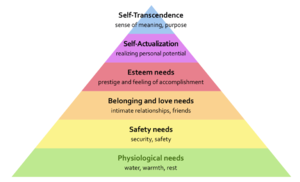Maslow's hierarchy
Everyone is driven to do stuff by a need, however, some needs come before others. Abraham Maslow, an American psychologist from the early 1900s, suggested that there is a defined hierarchy (see Figure 1), where the most important needs at the bottom have to be fulfilled before a person moves to the next, stage above. For instance, if you are hungry you need to buy some food to eat, if you are cold you need to light a fire to to get warm. Once these basic needs (in green - Figure 1) are met, then people can move up towards psychological needs such as building relationships and esteem.
Maslow's Hierarchy and Earth Population
In essence, Maslow's hierarchy of needs emphasises that basic human requirements must be fulfilled before addressing broader, more common issues. With approximately 9.2% of the global population, equivalent to 719 million people, living in extreme poverty without access to essentials such as food, clean water, sanitation, health, shelter, and education, it seems impractical to expect a unified response to humanity's wider common problem the ecological crisis.
So is the earth is doomed? It seems that humanity is reluctant to give up its old ways and many have been looking for a technoutopian solution come to save us or an anthrospermist one, to get the hell out of here. For those of us not in the 1% or cannot afford an interplanetary rocket, it seems our best bet, is to change what is in reach. We have tried to change the problem only to be defeated by greenwashing and jevons paradox exposing them as symptoms of a much larger broken system. The only thing we have left, is to act locally, work on ourselves and then propagate this collectively across the world. By doing this we can effect change.
However, to start doing this we need to be able to effectively change people's minds, to unlearn bad habits and learn new ones. The traditional way to do this is activism. To actively go out with signs and banners and petition police and politicians for change. It was once thought that only 3.5% of the populace was needed to become actively involved to make a change[1]. However, with the failings of Extinction Rebellion, Greenpeace and countless other organisation this seems like a far away goal. But perhaps there is a new way... Recent scientific research has shown us that there is a very effective way to change peoples minds, by the inducement of pivotal mental states. It has been shown that this can help people unlearn logical fallacies, popular delusions, and cognitive biases.
References
- ↑ The Success of Nonviolent Civil Resistance. Erica Chenoweth Professor of Public Policy at Harvard Kennedy School Susan S. and Kenneth L. Wallach Professor at the Radcliffe Institute for Advanced Study TEDx 2013. (2021). Retrieved from https://www.nonviolent-conflict.org/resource/success-nonviolent-civil-resistance/
